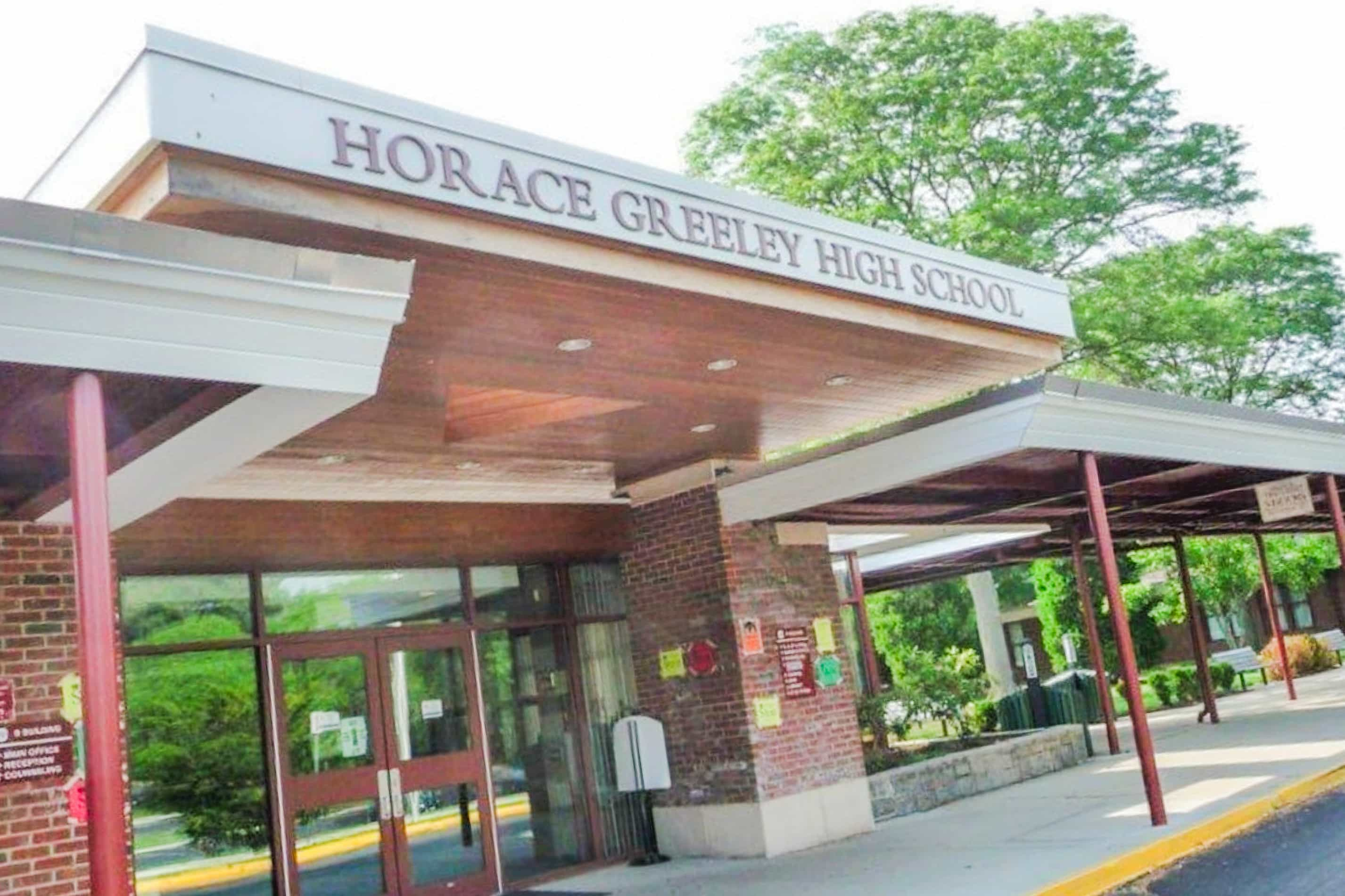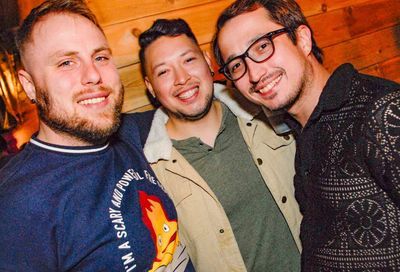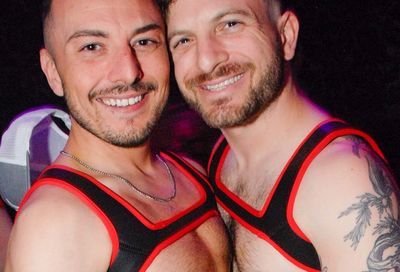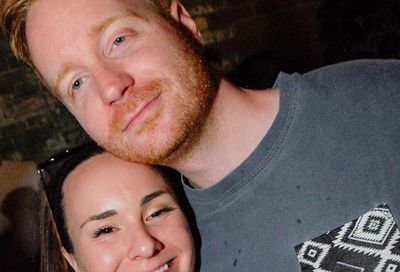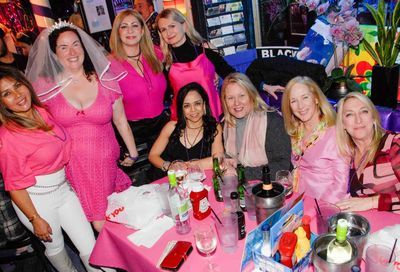Newseum’s “Rise Up” and The Hamilton’s Newsroom suite offer memorable LGBTQ experiences
Dive into an exploration of LGBTQ history at the Newseum, or just sleep surrounded by history at The Hamilton

Visitors with knowledge of queer history might approach the Newseum’s Rise Up: Stonewall and the LGBTQ Rights Movement exhibit with their own established angle on the story being told in this exploration of 50-plus years of change. The exhibit follows its own unique approach, reflecting the Newseum’s mission to increase public understanding of a free press and the First Amendment.
“We take a newspaper, periodical skew at things,” says the Newseum’s exhibit writer Christy Wallover. “The intersection between the LGBTQ rights movement and our mission is such a fantastic, depthful one, because it really is everyday Americans seeing an injustice or being discriminated against, seeing prejudice and making a change through petitioning their government, through protesting peacefully, trying to really cross that division and see change.”
The Newseum doesn’t have curators on staff, so, for the exhibit — on view through December, on the building’s sixth floor — Wallover met with consultants from the LGBTQ community to identify the stories that should definitely be covered. “And then I worked with our collections department and our visual resources department to select artifacts and images for the exhibit.”

Of those artifacts, films, photos, and personal items on display — from seminal gay ‘zines and Jim Obergefell’s wedding rings, to an original colors rainbow flag by the flag’s creator, artist Gilbert Baker, and an AIDS quilt panel made in tribute to legendary trans activist Cheryl Courtney Evans — Wallover lists the exhibit highlights as “all of it, because all of it is so really cool.”
Still, she points out that the three Newseum-produced films in the exhibit should not be missed. “One is called LGBTQ Voices, and you see that right when you come off the elevators. That film interviews everyday people. We did a casting call throughout D.C. for people to come in and tell us about their stories. People of all different ages, ethnicities, sexual orientations and gender expressions and identity came in, to share with us their experiences. It’s a wonderful, fascinating, personal touch narrative,” she says.

Another film in the exhibit, The Hollywood Effect, “discusses how the portrayal of LGBTQ Americans has changed over time and shifted from a portrayal of sad and depressed and suicidal people, to one of thriving and successful and happy individuals.” Featuring interviews with film and cultural critics, as well as celebrities like George Takei, Jesse Tyler Ferguson, and Sarah Ellis of GLAAD, The Hollywood Effect also explores “how the shifting of the narrative in mainstream pop culture has helped shift the stories that people read and think about,” says Wallover.
But it’s the third Newseum-produced film in the exhibit, Into the Streets, that will likely have the biggest impact for those familiar with LGBTQ history. A film about “Pride and people harnessing their First Amendment freedoms to assemble in protest for change,” according to Wallover, Into the Streets gathers footage of Stonewall in ’69 and the first Pride march, then known as the Christopher Street Liberation Day Parade. Interviews with activists like Nicole Murray-Ramirez and with Mark Segal and Martin Boyce, who were at the Stonewall Uprising, prove not only enlightening but deeply affecting.
Equally moving are exhibit displays acknowledging those vital mini-uprisings that pre-dated Stonewall, like the Frank Kameny-led protest in front of the White House in 1965, demanding equal treatment in the workplace, or the 1966 “sip-in” staged by the New York Mattachine Society at one of the city’s many cocktail bars that refused to serve gays and lesbians.
While bringing to light some forgotten heroes, the Rise Up exhibit does not wade into the ongoing debate about who threw the first brick at Stonewall. “From my research, it’s really speculative of who did it, there’s not one person,” says Wallover, “so we don’t cover that in depth. What we do cover is how the uprising galvanized the community, and we also talk about how it was the most marginalized of the LGBTQ community to fight against police harassment. So street youth, transgender youth, and the most effeminate men at the time were really the ones throwing punches and getting punched by police. So we covered that, but we don’t necessarily try to identify who threw the first brick. It was many people who took part in the Stonewall Riots and protesting that afterwards as well.”
Without precisely acknowledging who did what during the Riots, the exhibit does include details about the pioneering work of trans activists Marsha P. Johnson and Sylvia Rivera. Those who know and cherish those women might discover other beloved figures in the movement missing from action here. And The Hollywood Effect — the exhibit, in general — certainly could do more to clarify the relationship between the mainstream and the underground. Ellen and Will and Grace and Rupaul all moved culture, and so did John Waters and Divine and Sylvester and Mapplethorpe and Tom of Finland.
Senator Tammy Baldwin’s suit is on display, but if Bayard Rustin is featured somewhere in there, we missed him. Visitors will get their fill of Anita Bryant, though, and how her anti-gay campaigning galvanized a liberation movement. In fact, Rise Up, accounting for all its components, does capture the fight for liberation — but then skips over the actual being liberated (i.e.: the sex and sexuality), to dive right into the AIDS era.
Sex, for the most part, is left out of what is still an inclusive, accessible journey. And, in any case, the timing couldn’t be more right to reconsider the half-century since Stonewall through the Newseum’s pro-First Amendment lens.
The exhibit certainly will add some new angle to each visitor’s personal story, if only for the opportunity to view one small, special item: a bullet-riddled letter that was tucked inside Harvey Milk’s jacket pocket when he was assassinated. The handwritten note, about an item of civic business Milk planned to attend to, offers a subtle, powerful notion of the leader the LGBTQ movement lost that day in 1978. What if Harvey had lived to take on the AIDS epidemic, or marriage equality? How would he celebrate Pride in 2019?

Milk’s story is just one of the personal narratives of LGBTQ icons that are extended from the Newseum’s exhibit galleries into the nearby Hamilton Hotel, on 14th and K Streets. In commemoration of LGBTQ Pride and the 50th anniversary of Stonewall, The Hamilton has decorated its fourteenth-floor Newsroom suite with Rise Up artifacts, specially curated by a modern iconic gay, Alan Cumming.
Guests in the luxurious suite get a really fabulous room, plus a birds-eye view overlooking Franklin Square, free tickets to the Newseum, and their very own in-room museum displays, featuring, among other things, a copy of the script of Ellen‘s coming-out episode, signed by Ellen; a program from the first Gay Games in 1982; an LP by The Village People; a novelization of the groundbreaking PBS series An American Family (a cheeky choice by Cumming); and a particularly illuminating page from a 1967 issue of The Los Angeles Advocate, with a story on a meeting between cops and LGBTQ community leaders.
The suite is a sweet way for queer folks and allies to celebrate their freedoms, by spending the night with whatever consenting adult they feel like bringing. Although, they might have to get used to the idea of sleeping under the watchful eyes of reformed Trump-booster Caitlyn Jenner, who stares down sultrily over the bed from a framed poster of her Annie Liebovitz-shot Vanity Fair cover. Maybe The Village People might make for more fun in the Newsroom bedroom.
Rise Up: Stonewall and the LGBTQ Rights Movement is on exhibit through December 31, 2019 at the Newseum, 555 Pennsylvania Ave. NW. Tickets for general admission are $24.95 for adults, $19.95 for seniors, and $14.95 for children ages 7 to 16; ages 6 and under free. Call 202-292-6100 or visit www.newseum.org.
The Hamilton Hotel is located at 1001 14th St. NW. For rates, call 202-682-0111 or visit www.hamiltonhoteldc.com.
Support Metro Weekly’s Journalism
These are challenging times for news organizations. And yet it’s crucial we stay active and provide vital resources and information to both our local readers and the world. So won’t you please take a moment and consider supporting Metro Weekly with a membership? For as little as $5 a month, you can help ensure Metro Weekly magazine and MetroWeekly.com remain free, viable resources as we provide the best, most diverse, culturally-resonant LGBTQ coverage in both the D.C. region and around the world. Memberships come with exclusive perks and discounts, your own personal digital delivery of each week’s magazine (and an archive), access to our Member's Lounge when it launches this fall, and exclusive members-only items like Metro Weekly Membership Mugs and Tote Bags! Check out all our membership levels here and please join us today!





